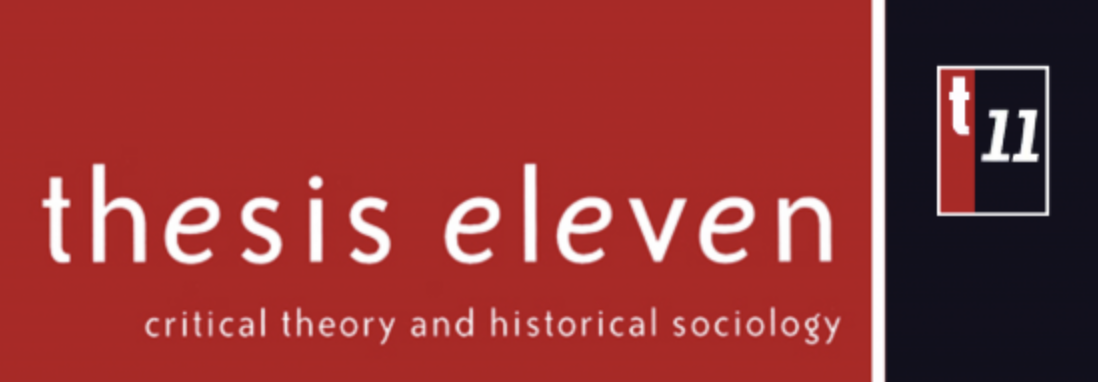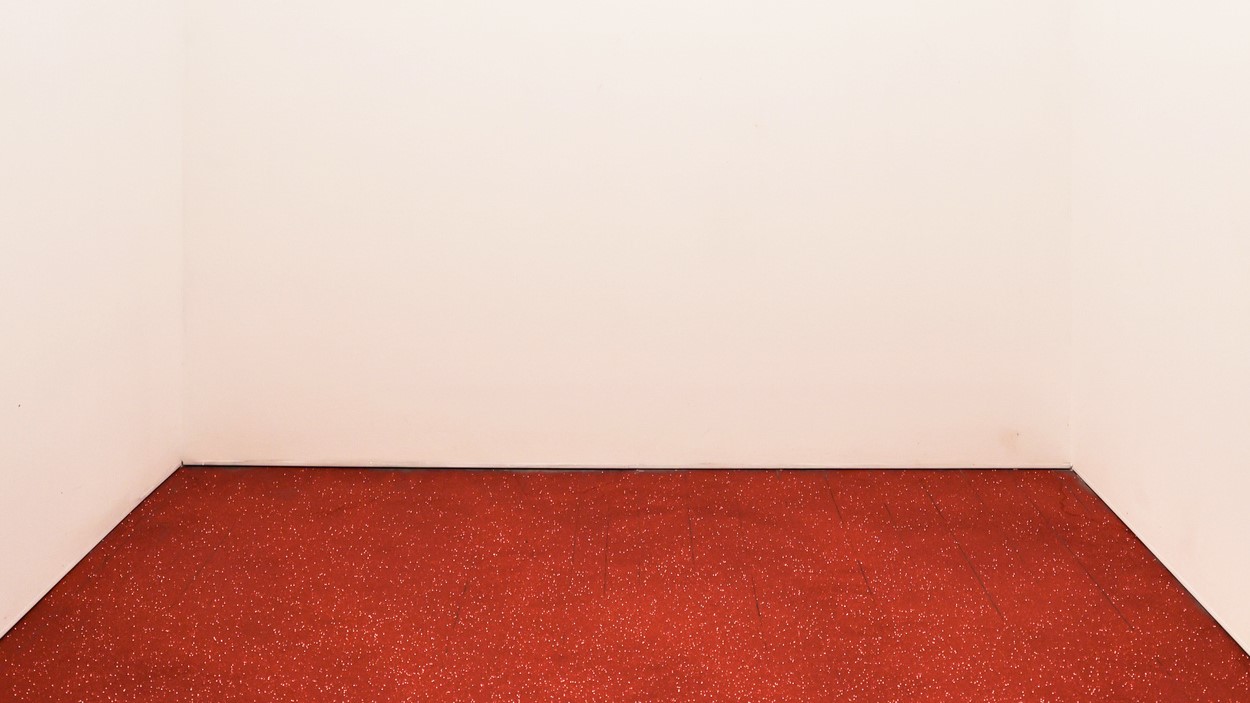
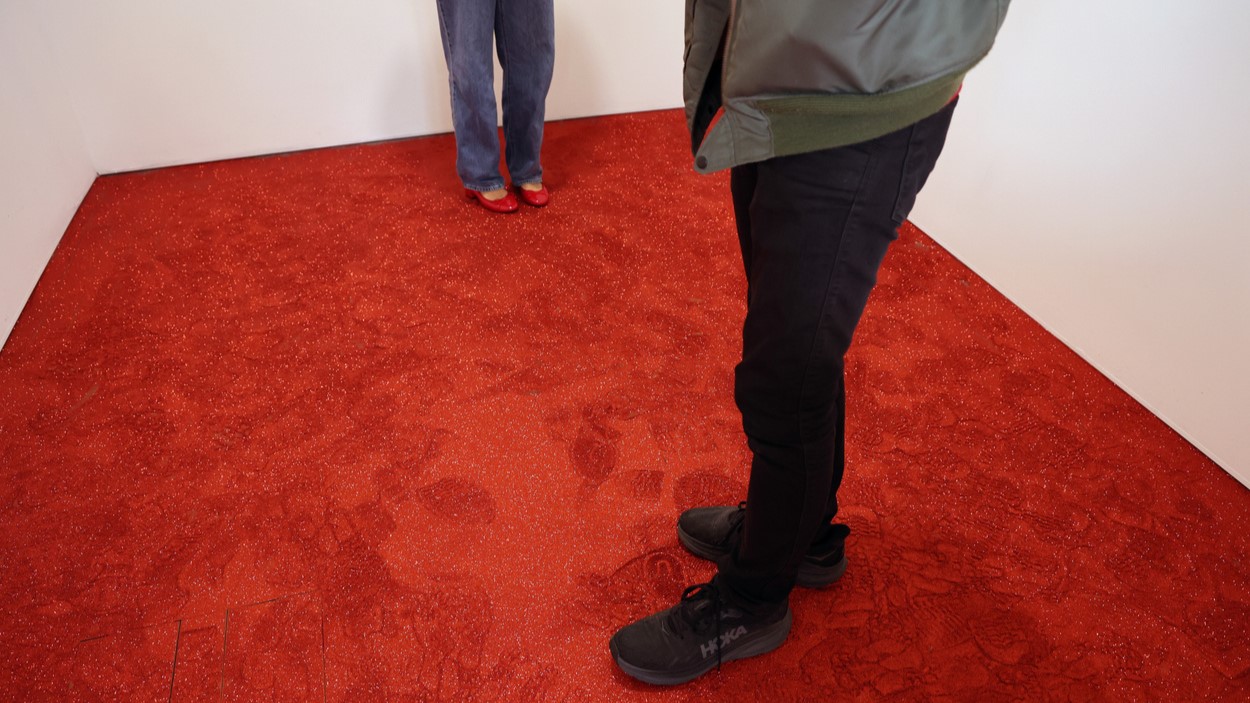

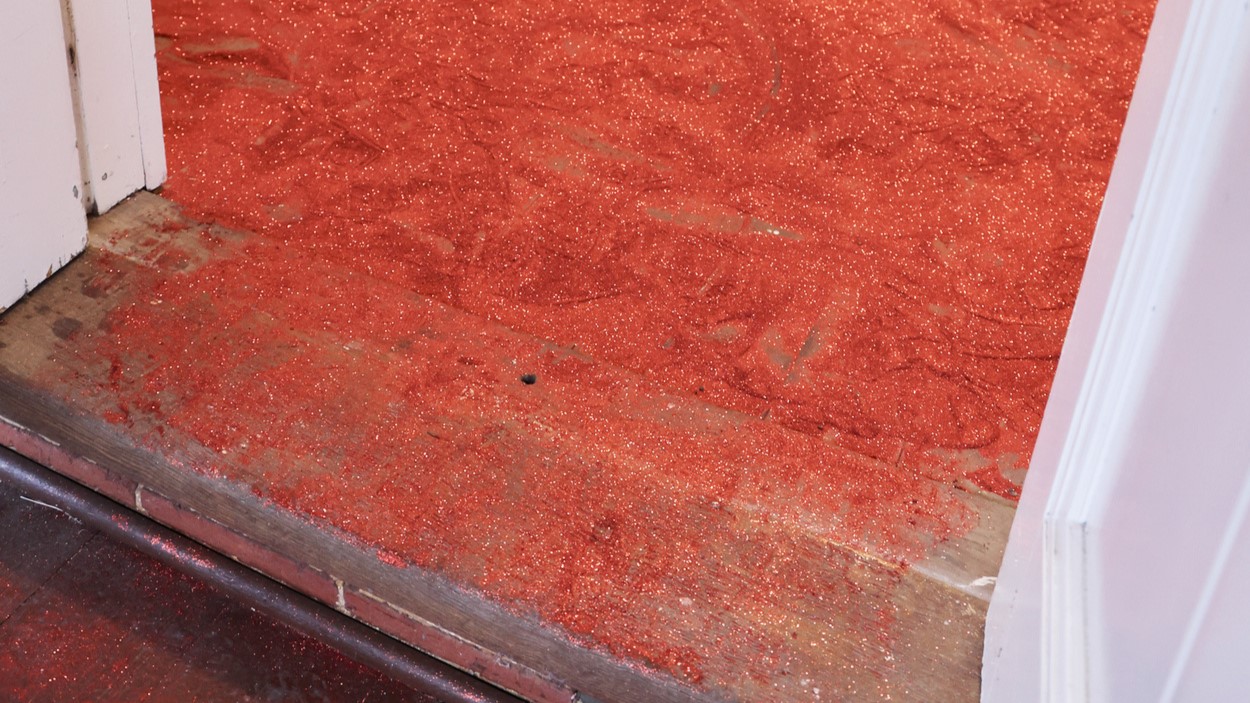

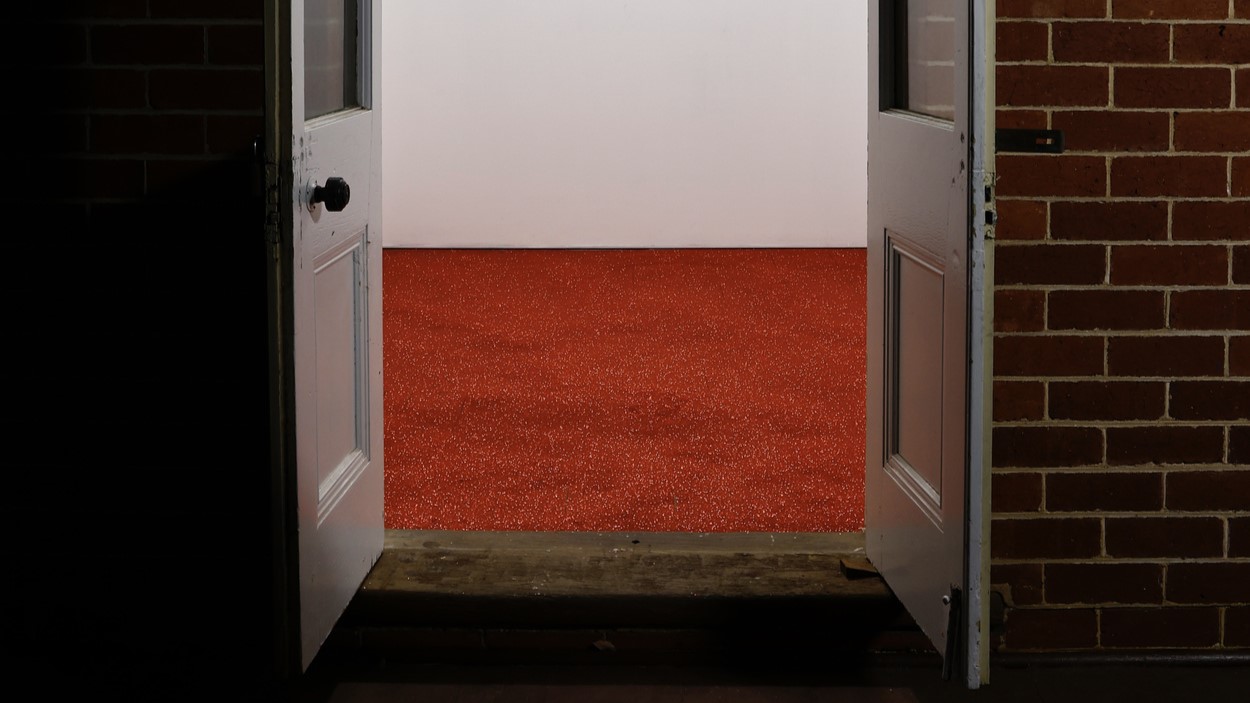
At the throne of God,
In blissful paradise,
Red snow — bloody red —
Will stand before our eyes!’
— Peter
Yakubovich, “Red Snow”, 1905.
In 2005, Tony Blair became the longest-serving Labour PM in the UK; Hurricane Katrina devastated New Orleans; the London bombings struck the city’s public transportation system; Paris was engulfed in 21 days of rioting in protest of youth unemployment and police harassment; the Kyoto Protocol took effect; Pope John Paul II died; and Liam Gillick exhibited, for the first time, The hopes and dreams of the workers as they wandered home from the bar. The work—a large quantity of red glitter strewn across the concrete floor—was central to Gillick’s eponymous exhibition at the Palais de Tokyo, Paris, in 2005.[1] A couple of years later, reflecting on the work, Gillick remarked:
Consider, for example, a body of work taking as its starting point the idea of a group of laid-off car workers returning to their now abandoned factory, and who subsequently seek to create a resolved ecopolitical equation of totalizing relationships. Don’t attempt to illustrate any of this directly but heap 440 pounds of red glitter on the floor. Red snow? Dispersed form?[2]
The swirling politics and media of pre-GFC Europe appear with the grace of historical hindsight a fitting environment for such an artistic speculation to occur. Twenty years later, no longer in Paris, France but at Disneyland Paris (David Attwood’s gallery in Ardross that Dispatch readers will undoubtedly be familiar with), how might one make sense of a restaging of a work like The hopes and dreams […] ?
There’s a kind of maddening quality that characterises Gillick’s works. Perhaps ‘cerebral’ is more apt. ArtReview has referred to it as “essayistic”.[3] Others might think of Gillick as an “artist’s artist”: itself a fraught phrase, but one that describes Gillick’s relentless appeal (particularly in the referentiality of his oeuvre; one that’s history-soaked, conceptually heavy, and visually restrained). In many respects, The hopes and dreams finds a perfect home at Disneyland Paris; a gallery far enough from any civic or municipal centre that the likelihood of someone happening upon it by chance is nigh on impossible—in this sense, it’s an elected space, one for the in-crowd, or those in the know about contemporary art.
Aiding with interpretation of his minimalist installation that initially seems to sit at odds with its narrativised title, Gillick’s artist statement informs us ‘... modern glitter was perfected on a cattle farm in New Jersey in 1934 ... but of course, red glitter is red snow and red snow is what you get in times of revolution.’ Red snow immediately conjures associations of “Bloody Sunday”, the shooting of workers protesting tsarism that is commonly heralded as the beginning of the 1905 Russian Revolution, and is also the subject of Russian poet and revolutionary Peter Yakubovich’s poem. Gillick goes on in a subsequent interview: ‘When there’s red snow, you know something bad has happened.’
The last time it snowed in Perth was reportedly 1968—another globally significant year for workers and revolutions. By chance, 1968 also happens to be the year that the building which is occupied by Disneyland Paris ceased its usage as a home for workers; those from the radio telecommunications station positioned above (Wireless Hill Station, built 1912, closed 1968).[4]
The uncomfortable sense of displaced violence within The hopes and dreams rings out as obstinately shrill and sinister, both because of where the work has been and because of where it is now. Australia has a certain comfortability in ignoring massacres and refusing to confront its past. In Gillick’s work, the glitter functions both superficially and substantially, resisting such ignorance. By leaving traces on its viewers, and forcing itself out of the isolated gallery environment, both the glitter and the work become impossible to forget (the next time I picked up the shoes I’d worn to the opening, still with traces of red glitter in the seams, I couldn’t help but laugh, ever so slightly annoyed at the artist).
Prior to entering the gallery space, the square meterage of the wooden floor shimmered enticingly like a pseudo-minimalist ab-ex colour field. Inevitably audiences were faced with a choice: to trod on the glitter or to recoil, renounce entry, excuse oneself and maybe go and get a beer from the esky on the surrounding verandah. After the boots of gallerygoers marched over and through the work, physically and visually the red glitter became dishevelled, lacklustre, indifferent. In 2025, artists are no longer easily identifiable as just blue or white collar. Our participation as the attending crowd was inevitable, encouraged, coaxed in by the sparkle. Glitter is used in fishing lures to much the same effect. Were we the workers enacting our own failed revolution, trampling on our own ‘hopes and dreams’? Did we, the audience, unwittingly become the bloodstained and spectating bourgeoisie? Or as the esky might suggest, were we merely still at ‘the bar’?
I’d like to offer a resistant reading of this work. A room in a shed became a womb with a red lining, ready to shed. Gillick’s glitter had me thinking about that line in Fleabag, about women inherently having violence and blood built up inside of them, and men desiring to seek this violence out. It had me thinking about the phrase “mollescent irritant”.[5] It brought to mind a poem from New Yorker (Gillick lives in New York), Ben Lerner:
Real snow
on the stage.
Fake blood on the snow
Could this go
on forever in a good way? [6]
It had me thinking about how the so-called father of minimalism and putting things on the floor, Carl Andre, probably pushed Ana Mendieta out of that window in NYC, but also about how it doesn't help to talk about that anymore. [7] The formal qualities of The hopes and dream recall Mendieta’s own Body Tracks (1974), albeit to very different conceptual ends: Mendieta’s bloodstained “tracks” registering a bodily motion across a white canvas surface, versus the footprints of visitors leaving their own index on The hopes and dreams. I couldn’t help but think about Carolee Schneeman’s later response to Mendieta’s death; Hand Heart for Ana Mendieta (1986) made from paint, actual blood, ashes, and syrup on snow.
In its plastic participation, Gillick’s installation reminded me closely of Yayoi Kusama’s work at the 2017–18 NGV triennial, albeit inversely; both artists having attempted to obliterate a room in small and smaller red dots. Having seen the Kusama in the flesh, there was something underwhelming, even robotic, about that installation; it worked best for the many gleeful kids who were there. Meanwhile, the Gillick in Perth conjured a weird adult joy: the twinkly crimson sticking to shoes and clothes, pouring outside of the gallery onto the porch of the old building, eventually leading all the way back to our waiting car doors. The Gillick wasn’t safe for kids; glitter can cause instant death via respiratory failure upon inhalation. Morbidly, I couldn’t help but fleetingly imagine myself as an art critic choking to death on something so beautiful. A hundred different interpretations of this work atomised like its billion flecks of red, including that line from Richard Siken: I’m bleeding, I’m not just making conversation.[8]
In 2005, I was in primary school. Red glitter was a status symbol to me even then: at the local dance eisteddfod (annual competition). The painted lips of my competitors, all female, at a rival dance school—where the parents spent more money on costumes and fees—were covered in red glitter on top of their brick-red lipstick. We, the classical ballet school, called it ‘tacky’ and then proceeded to admire their acrobatics onstage, dismissing them as ‘tricks’. A trick; a parallel to conceptual art’s contingent or clue-like status, its perceived fraudulence to ‘mainstream’ audiences, AKA people who don’t drive 30 minutes in the rain to see a heap of glitter on the floor from some big name international artist, or read Dispatch Review. Red glittered lips, the equivalent of a team jacket or a brand. Many previous productions that featured iterations of Dorothy’s slippers had also covered that backstage greenroom in shiny dust. The footprints leading out of Gillick’s exhibition suggested a hunt, a chase, a crime scene, or maybe, a walk through revolutionary red snow, if you live in a place cold enough for that to happen. In 2025, glitter carries a heavy, heady note of nostalgia and dread; as a microplastic that doesn’t break down in nature. Recalling more innocent (or perhaps ignorant) childhood times in craft rooms and kindergartens, on stage, prior to an ongoing awareness of massacres and mass environmental destruction. Perhaps this muddied quality—the “essayist” nature of Gillick’s work—is best captured in a borrowed line from critic John Berger: that to participate in this work is to accompany something (in)visible to its incalculable destinations. It goes without saying, but the letters in ‘maddening’ can be rearranged into the word ‘demanding’, something that this work also is. Like its component material of red glitter, or history itself, Gillick’s work sticks around unclearly in the mind, conjuring a rapid fire of associations, long after its material presence has supposedly disappeared.
Liam Gillick, The hopes and dreams of the workers as they wandered home from the bar, a Disneyland Paris, July 20 – August 17, 2025.
Footnotes:
1. It has since been shown at Pinacoteca Agnelli, Turin, in 2022, and at Kunsthaus Graz, Austria, in 2024.
2. Liam Gillick, Vegetables, Art Forum, March 2007 https://www.artforum.com/features/vegetables-175246/
3. Pádraic E. Moore, Liam Gillick and the Idealistic Impulse, ArtReview, 28 May 2024
4. See more on the Wireless Hill site and history at the Heritage Council of WA: https://inherit.dplh.wa.gov.au/Public/Places/AggregateDetails?lgaContains=melville&streetNameContains=&isCurrentlyStateRegistered=False&SearchToken=e842ecec-fa03-45e8-aae1-75b695785bf3&page=3&ItemsPerPage=20#:~:text=Wireless%20Hill%20Park%2C%20comprising%20brick,valued%20area%20of%20urban%20bushland.
5. From a Mina Loy poem ‘The Effectual Marriage’ in The Lost Lunar Baedeker, Poems, selected and edited by Roger Conover, 1996, New York, Farrar, Strauss and Giroux
6. From an untitled Ben Lerner poem in The Lichtenberg Figures, Copper Canyon Press, 2004
7. Interestingly, Gillick recalled meeting Andre in a conversation with curator Nicolaus Schafhausen last year. They were discussing Gillick’s work for the German Pavilion at the 53rd Venice Biennale, How are you going to behave? A kitchen cat speaks—a maze of kitchen cabinetry—when Gillick remarked that “the kitchen was the last great battleground for modernism […] the only part of the house that is minimal, that has straight lines.” Gillick visited the “miserable-looking” Andre with artist Sarah Morris—then his wife—to explore the possibility of republishing some of Andre’s poetry. He recalled how Andre went after Morris like many “pig-men of a certain generation [who] see an intelligent woman and go after them.” Andre told Morris, “Your art is like skirt lengths; it just changes year by year.” To which Morris replied, “Your only contribution to history will be kitchen design.” Available: https://youtu.be/pKcJxXH00fE?si=tJfIQq65iHfgfAKj&t=2134
8. This is a line from the Richard Siken poem, Wishbone, in Crush.
Images courtesy the artist and Disneyland Paris.
